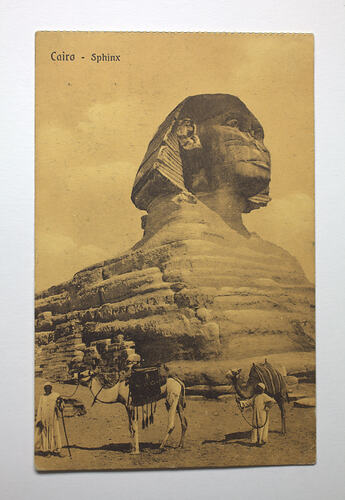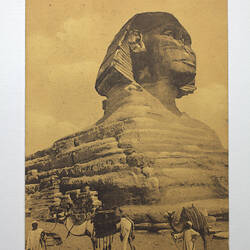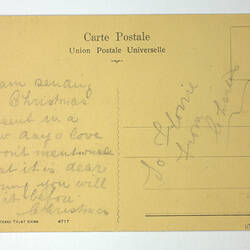Summary
Postcard from a World War I album from Egypt containing 33 postcards, most featuring Egyptian themes. Of particular interest amongst these postcards is one containing a letter written to 'Father' (presumably John Peile Snr) signed by 'VS' that mentions Albert Peile. The inclusion of this postcard suggests that the album either belonged to or was compiled by John Peile Snr or another member of the Peile family.
Sepia image of the Great Sphinx on the Giza Plateau, Egypt. The postcard is addressed to 'Florrie,' a possible reference to Florence Mary Peile who was John and Albert Peile's sister, and is signed by 'Charles.' It is unclear how Charles is connected, if at all, to the Peile family.
The Great Sphinx was built in the quarry beside the pyramids of Giza, close to the Valley Temple of Khafre, a Pharaoh of the Old Kingdom. The Great Sphinx is believed to have been the oldest in Egypt and spent much of its existence covered by the desert sand. Although uncovered during ancient times by Thutmose IV, and the subject of several subsequent attempts, it was not until 1936 that the Great Sphinx was completely exposed. The Great Sphinx in the image has not been completely uncovered, although it shows evidence of Gaston Maspero's 1885 excavation work.
Part of a collection of material relating to the World War I service of brothers John and Albert Victor Peile, who both died in the conflict. Younger brother Albert enlisted first. He was a 22-year-old unmarried clerk when he enlisted on 27 August 1914, service number 769, 3rd Battalion. He served in Gallipoli and later France, and was eventually promoted to the rank of corporal. He died in Bullecourt, France on 4 May 1917 and his body was never found. He is commemorated at the Villers-Bretonneux Memorial. His brother John Peile was a 38-year-old unmarried miner when he enlisted on 25 June 1915, service number 2662, 2nd Battalion. He also served in in Gallipoli and France, and was similarly promoted to corporal. He died in France on 18 September 1918 and is buried at Roisel Communal Cemetery Extension, France. Their mother died only a few years later in 1926, aged 73. Their niece was Mrs M. J. Hitchens, the donor.
Description of Content
Half front view of the Sphinx.
Physical Description
Sepia image of a large sphinx wearing the nemes headdress and partially covered by sand. In the foreground stands a man, facing the front, wearing native dress and holding the reins of a camel. A second camel stands in the lower right corner.
More Information
-
Collection Names
Military Memorabilia Collection, Returned and Services League (RSL) Collection
-
Collecting Areas
-
Acquisition Information
Donation from Victorian Branch, Returned & Services League of Australia Limited (RSL), Mrs Margaret J. Hitchens, 1986
-
Place & Date Depicted
Giza Plateau, Egypt, 1914-1918
Approximate date, based on dates of World War I -
Format
Album
-
Inscriptions
Printed in black ink on the front of the postcard: 'Cairo - Sphinx' Hand-written in pencil on the back of the postcard, left hand side: 'I am sending / a Christmas / Present in a / few days love / I won't mention / what it is dear / hoping you will / get it before / Christmas' Hand-written in pencil on the back of the postcard, right hand side: 'To Florrie / From / Charles'
-
Classification
-
Category
-
Discipline
-
Type of item
-
overall dimensions
88 mm (Width), 135 mm (Height)
-
References
Allen Winston, 'The Great Sphinx of Giza: An Introduction,' TourEgypt.com, at: [Link 1] accessed: June 15, 2012 For Albert Peile's war record see the National Archives of Australia website at: [Link 2] For John Peile's war record see the National Archive of Australia website at: [Link 3]
-
Keywords
World War I, 1914-1918, Egyptian Archaeology, Sphinx, Camels, Postcards, Christmas


